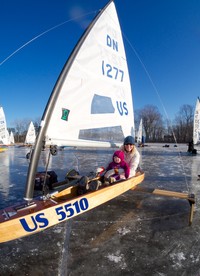Building a NITE Plank
Constructing a NITE plank, by Corey Hughes, NITE 341, 2003
The original gull wing plank of a NITE is well suited for its intended purpose, i.e., handling the weight of the captain and a passenger. But my 1974 plank had developed a nasty twist and was also really wild in heavy air. Being an old motor cycle wheelie fan of many years, I loved the ability to throw the NITE in the air at virtually any given moment, even with a guest aboard. But great hikes aside, you do go faster if you stay closer to the ice. After several conversations during the spring and summer of 2003, fellow GTIYC member and friend Bob Gray convinced me, that with his guidance, I could and should build my first plank. A retired airline pilot and expert DN builder, Bob’s knowledge was a thing to behold. Grabbing pencil and paper, Bob spit out wood characteristics, flex strength values and formulas faster than I can remember my own children and grand children’s names. Although he kept reminding me that he had never built for anything other than a DN, I was convinced anyone with all those numbers at the tip of his tongue couldn’t be very far off, and as it turned out, he wouldn’t be!
We laid out the plank in a three layer design, solid Poplar core with stripped Ash skins on the top and bottom. Holding to NITE overall specifications, we tapered the thickness of the Poplar core from 1-1/8 inch at the sides of the hull, down to 1-3/4 inch at the chock ends.
The outer skins of Ash were laminated together in 9/16” x 1-1/4” x 11’-6” strips. After setting up, the strips were run through the planer to 7/16”. The final pieces were butter up and bowed on the backbone to 3 inches arch, adjusted many times with long aluminum bars to correct for twist, and finally clamped down with more clamps than I though any one man could ever own. Bob’s comment when asked about his wide array of clamps, “When my family asks what I want for Christmas, the answer is always clamps!” If no other lesson was to be learned from my plank building, I decided right there and then that from that time on my Christmas list would also be for “clamps.” He estimated that his 55 gal. barrel contains about $600 of the marvelous little tools.
After allowing 48 hours of curing of the Merton’s System Three, a big moment came when the clamps were released. Never having worked with a plank of this length, Bob estimated that the clamped crown of 3 inches should snap back to about 2-1/2 inches. Well, it did exactly that. As for flex, we had hoped for something around 170 pounds per inch, but the scales showed this new plank to be 220. Before taking anything off it, Bob recommended that I sail it for a few days to get a feel for what we really had. So after we had aligned and drilled for the boat mounting and chock holes, I did some rough final shaping and sealed everything up with several thinned coats of Merton’s. Because it is a 2-1 ratio epoxy, the Merton’s was easy to use and didn’t require all the pumps used on other products. I have been very pleased while using it and with the final outcome.
The plank was sailed several times and responded very well. Although noticeably softer and lighter (about 18 lb) than the original plank, photographs taken at speed indicated that it could be thinner yet. Back on the bench, I spent several hours with a power planer on both the bottom and top sides. After every two or three passes, the plank was set on very slippery surfaces and the center point deflection was re-measured with my weight placed in the center. Towards the end of the planing, I would re-measure after every pass of the planer, and stopped when my weight finally straightened the plank, which calculated to be spring rate of 150 pounds per inch.
I was pleased to find that because of the curvature of the plank, the power planner had not removed a consistent thickness of wood, but had created a very nicely tapered plank. The plank was final sanded and sealed, and new rubber step plates installed. The Traverse City area was snow bound and it would be almost six weeks before the big moment of truth. On the ground it was very springy and seemed almost perfect. Finally, North Torch Lake was blown clean and it was time to test. Things could not have been better. It sailed like a dream, absorbed the largest of gusts, and performed great, long, controllable hikes.
The down side, two 200 pound riders will bottom out harshly at high speeds in heavy or rough air. So, what to do? I guess it is time to build another one, and stiffen this first one with glass for taking a guest.
See you on the ice!
Check articles on www.gtiyc.com for construction pictures.
- ISA-GT341's blog
- Login or register to post comments
- 4060 reads

Comments
nite plank
What advantage would I notice by building a plank of ash over just planing down the sitka plank that I already have? Is ash more durable when flexed? I know ash is less expensive and heavier. Tom Austin Nite 563
Why Ash?
Tom:
I don't know of any advantage over your Sitka one. As you noted, the Ash is substantially less expensive and has tremendous tensile strength and spring rate. The Ash skins ended up being hand tapered quite thin to get the final 150 lbs/inch deflection rate that I wanted. The final plank weighed 36 lbs, a big improvement over the 53+ of the original yellow pine.
Keep'em Sharp
Corey Hughes, Nite 341
Keep'em Sharp
Corey Hughes
Traverse City, MI
ISA-GT341